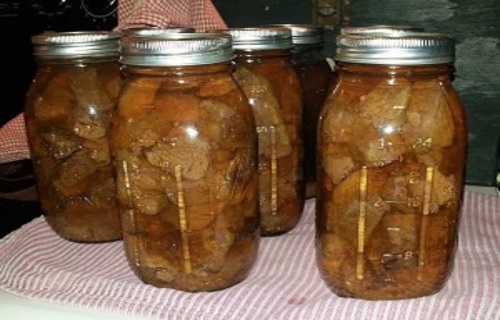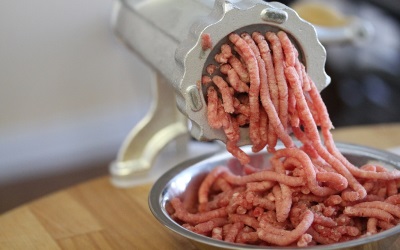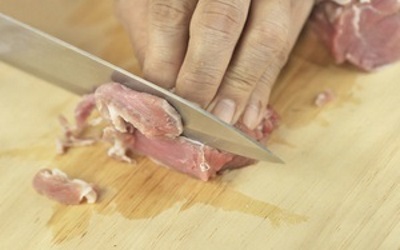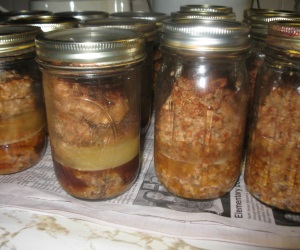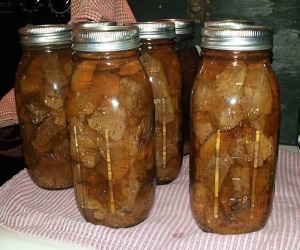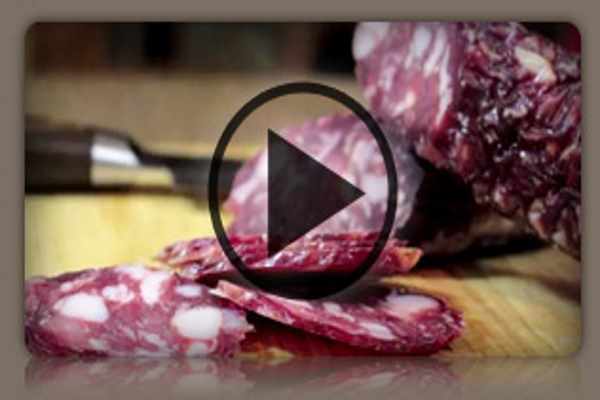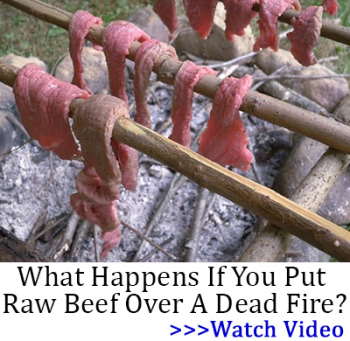How to Canning Meat
- Beef, venison, elk, or pork
- Salt (optional)
- Water
- Canning jars, lids, and rings (quarts or pints are fine)
- A pressure canner
- Trim the meat to remove excess fat and gristle. (I usually try to do this when the meat is half-frozen. It makes the trimming much easier)
- Slice into strips against the grain, and then cut into roughly 1″ cubes (just eyeball it– no need to be exact).
- how to can beef, venison, or elk with a pressure canner for fork-tender meat!
- Place the cubes into a large stockpot and brown thoroughly on all sides. If your meat is especially lean, you may need to add a bit of fat (such as bacon grease, lard, or coconut oil) to the pan to prevent stickage. (Yes, that’s a word)
- The goal here is to simply brown the cubes— you don’t need to cook them all the way through.
- how to can beef, venison, or elk with a pressure canner for fork-tender meat!
- Place the browned meat cubes into clean glass jars, leaving 1″ headspace. If using quart jars, add 1 teaspoon of salt. If using pint jars, add ½ teaspoon of salt.
- how to can beef, venison, or elk with a pressure canner for fork-tender meat!
- Pour water (how much you need will depend on how many jars you are canning) into the pot you used to brown the meat, and bring it to a boil. This will capture all the lovely bits from the bottom of the pot and create extra flavor in your finished product.
- Ladle the boiling water over the meat in the jars, leaving 1″ headspace.
- Wipe the rims, adjust the lids/rings, and process in a steam pressure canner as follows:
- Pints: 75 minutes
- Quarts: 90 minutes
- Use 10 pounds of pressure, UNLESS you are 1,000 feet or more above sea level. If that is the case, increase to 15 pounds of pressure.
A grand encyclopedia of country Old Time Wisdom, weather wisdom, country remedies and herbal cures, cleaning solutions, pest purges, firewood essentials, adobe making and bricklaying, leather working, plant dyes, farm foods, natural teas and tonics, granola, bread making, beer brewing and winemaking, jams and jellies, canning and preserving, sausage making and meat smoking, drying foods, down-home toys, papermaking, candle crafting, homemade soaps and shampoos, butter and cheese making, fishing and hunting secrets, and much more. Old Time Wisdom: Traditional Skills for Simple Living
You can safely and easily can your own meat
Of all the foods I can every year, the most useful is the wide variety of meats. While we aren’t huge meat eaters, these rows and rows of jars of all sizes form the base of many meals throughout the year. And in our hurry-scurry world, it’s so convenient to have this pre-cooked, tender, and oh-so-tasty meat right on the shelves, ready to quickly whip up a meal that tastes like I spent hours preparing it.
At any one time, you’ll find jars of venison, moose, and elk meat, chicken, turkey, beef, ground meat, pork, and fish on my shelves. Two of the best things is that this meat was cheap (hunted, home-raised, or on sale) and it’s so fast and easy to can. I am able to ready over a dozen meals’ worth of meat in less than an hour. This is about the same amount of time it takes to prep and cook raw meat, and I have so many extra, ready-to-heat meals on my shelves.
Sure, you can freeze meat, as most people today do. But when you need that meat, you must either take hours to defrost it or use a microwave. Your meat can get buried with other things so long that it can become freezer burned, which gives the meat a bad smell and taste. When your meat is canned, it is all lined up in order and you can choose big chunks, steaks, slices or dices at a glance.
Last of all, and perhaps most important is that in a power outage of a week or more, you will lose all of the meat in your freezer unless you can somehow either keep it cold or move it all to another freezer somewhere outside of the outage area. I lost a big freezer full during an outage. I did all the right things; I covered it with heavy quilts, didn’t open it much, etc. But after several days, I was about to lose food, so I began canning on my wood range. I did save a lot of the most important food, but still had buckets that had to be carried to the dogs and pigs. It was a sad time to see all that good food that we had worked so hard to raise and put up, get tossed away. I swore “never again” and began canning and dehydrating all my food instead of freezing it.
As a bonus, your own home-canned meat contains nothing but what you put in with it: meat, water, and possibly salt and spices. After all, who can feel good about eating something you can’t even pronounce? Then there are the “hidden” ingredients in that store-bought canned meat—hormones, antibiotics, genetically-altered feed, bacteria, and mystery ingredients from sloppily processed meat.
But, you’ve heard, meat is hard to home can. You must be an expert to even think of trying it. If you do, you might poison your family. In reality, meat is very easy to can safely. If you have a pressure canner and can read directions, you can definitely do it. David, my sixteen year old son, has been helping me can meat since he was ten.
Basic equipment for home canning meat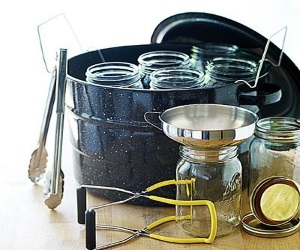
Because meat is a low-acid food, it must be processed in a pressure canner. This allows the meat to be heated at a temperature higher than boiling, which kills the dangerous bacteria that could cause food poisoning or illness. In a pressure canner, the steam causes the internal temperature to rise to 240° F, which is a safe temperature to process low acid food. A simple boiling water bath canner only heats the food to boiling, which is 180° F. This does not allow the food to reach a high enough temperature to kill possible bacteria, no matter how long you process the food.
Yes, in the “old days” people did can meat in a boiling water bath for 3 hours, but this was NEVER SAFE and people always risked food poisoning by doing this. You must use a pressure canner to home can meat.
Meat may be canned in quarts, pints, or half-pint jars. I usually do some in each size. In the past, I usually canned in quarts, but then I always had leftovers which needed to be refrigerated. Then I got smart and started canning in smaller jars. Now there is no waste, and I find that I actually turn to those smaller jars very often.
There has been a huge, ongoing debate for years and years about using “other” than Kerr and Mason jars for home canning. Some folks claim stridently that if you use jars that once held salsa or mayonnaise they’ll crack and break under pressure. But I can tell you that is not true. I’ve used hundreds of jars that were previously used for mayo, salsa, pickles, and more, for canning meat and other foods that must be pressure canned and those jars work just fine. Just make sure that a standard two-piece canning jar lid and ring fit the jar snugly. A major mayonnaise manufacturer uses jars that look like canning jars and the ring screws down, but when you add the lid, the ring just goes round and round, never tightening. Watch out for this.
When canning meat, it’s a good idea to have a jar lifter, which is an inexpensive heavy wire tong that grasps steaming hot jars and lets you lift them out of the canner when the processing time is done.
Safety in using the pressure canner
We’ve all heard the horror stories about a steam pressure canner “blowing up” in Aunt Mary’s kitchen, putting a hole in her ceiling. What they don’t tell you is that Aunt Mary screwed up badly. It’s just about impossible to blow up a modern pressure canner, but there are a few tips that will keep the process safe.
First, do not let any small children play around the stove when the canner is processing. This is just common sense. Canners are heavy and hot. Small children are curious and could pull the canner off the stove or turn the flame up under the canner without you noticing it.
When you are canning, don’t get distracted. You have to be right there to watch the canner during the processing time. Sometimes it only takes a very few minutes for the pressure to go from a nice ten pounds to a wild fifteen.
Even then, there is a safety on modern canners that lets off excess steam, if necessary, but don’t depend on that. Sometimes it will ruin the seals on your jars, going from a high pressure to a sudden drop. You don’t want to have all your work ruined.
If your canner has a dial gauge, make sure it is accurate. It’s best to take it to your extension office to have it checked before each canning season, especially if the canner is not new.
Make sure the vent holes in the canner’s lid are open. I blow through mine each time I go to use it, to make absolutely sure the openings are clear. Sometimes a small bit of food gets forced up into the openings, blocking them. This is dangerous and could cause extreme pressure to build up.
Read your canning manual each and every time you process a jar of meat. There are many variables, depending on the recipe and preparation of the meat. I’ve been canning since 1964, and every time I begin to process a food, I check my canning manual, just to be sure. No one is perfect and I don’t want to make a mistake. Meat is too precious, and so is the health and safety of my family.
Getting started
Let’s start with the very easiest meat to home can: stew meat. This can be beef or venison, including moose and elk meat. I put by more stewing meat than any other type of meat, besides ground. The reason for this is that I can use it for such a wide variety of recipes, from shredded meat for tamales and barbecue, to stews, chunky chili, and casseroles.
I like to cut my meat when it is slightly frozen. This makes it firm and it cuts easily and quickly. Warm meat or even chilled meat is harder to slice than meat that has some ice crystals in it.
To make stew meat, cut the meat across the grain, into one inch thick slices, as if you were making large steaks. You don’t have to cut the bone, just cut around it. Remove as much fat, gristle, and white muscle covering as you can. You want your home canned meat to be prime eating, and if you leave too much fat on the meat, you run the risk of having some jars not seal because the fat gets between the lid and rim of the jar during processing. Slice the meat into strips, then cut it into cubes.
Put the meat into a large mixing bowl and the scraps into another.
When you have a large amount, get out your canning jars and line them up on a folded clean towel on the table. Make sure there are no cracks or nicks in the rims of the jars. Then get out a box or two of lids, so you make sure you have them ready. Also find your jar rings and jar lifter. Set the pressure canner on the stove and put two inches of water in it, then the basket or bottom grate, depending on the brand of canner you are using.
Now get out your largest frying pan and put a tablespoonful of cooking oil in it and turn up the heat to medium. Add your meat until you have enough to fill the pan so the cubes are about two high. The reason you need to brown and partially cook the meat is twofold; it shrinks it, while adding flavor, and it heats the meat, getting it ready to process safely.
Season as you wish and stir until the meat is just browning.
Turn on the heat under your canner, leaving it open. Then place your canning lids in a small saucepan full of water and turn on the heat. Bring to simmering, then hold the lids in the hot water until you need them.
Now, with a slotted spoon, scoop up the meat and pack into your jars, to within an inch of the top of the jar. This leaves an inch of headspace. After all the jars have been packed, add enough water to the frying pan to make a broth to fill your jars. I sometimes add powdered beef soup stock to this broth to make it more “beefy” tasting. This is not necessary, though. When the broth is boiling, ladle it out and pour it into each jar, filling it to within an inch of the top of the jar.
Wipe the rim of each jar quickly with a clean damp cloth to remove any grease or meat particles. Place your hot, previously simmered lid on the jar and screw down the ring firmly tight. Place the hot jars into your hot canner, being careful not to bang them together. When all your jars have been placed in the canner, put on the lid and tighten it down. Leave the pressure weight off or leave the petcock(s) open, depending on the brand of canner you are using. Turn up the heat under the canner.
You must let the canner heat up and exhaust steam. This generally takes about ten minutes, although it can take longer when you have many jars in it. You want the steam to be exhausting forcibly, not just puttering out in little spurts and spits.
Meat must be canned at 10 pounds pressure, unless you live at an altitude above 1,000 feet above sea level. If you do, you must adjust your pressure to suit your altitude by the following chart:
Pints and half-pints of pork, beef and venison, including moose and elk meat, should be processed for 75 minutes, and quarts must be processed for 90 minutes.
When the time for processing the meat is up, immediately turn off the heat under the canner or remove the canner from the heat.
When you are canning meat products remember these things.
Let the pressure gauge return to zero or when using a weight gauge, let the canner cool for about 10 minutes, then gently nudge the weight. If it is still under pressure, a little spurt of steam will escape. If this happens, let it cool more. When no steam spurts out, remove the weight and open the canner carefully. Use caution when lifting the canner lid, as there is always more steam in it that will escape right into your face unless you’re careful.
Immediately lift out the jars with your jar lifter, and set them on a dry, folded towel out of any drafts. Setting a hot jar in a draft can cause cracking or a failed seal. Keep the jars an inch or two apart to allow for quick and thorough cooling, as this helps the jars to seal well.
As the jars seal, the lids will “boing” and “ping” intermittently. The liquid in the jars will still be vigorously boiling. This is normal. Do not poke at or even touch the lids while they are sealing; it can cause seals to fail. After the jars are cool to the touch, check the seals. A tight, dipped in the center lid is sealed. One that pushes down, then pops back up is not sealed. Refrigerate or
re-process unsealed jars right away, using a new hot, previously simmered lid. Inspect any jar that doesn’t seal for a tiny crack in the rim of the jar, often this is the reason they don’t seal.
Canning roasts or steaks
I home can many jars of different varieties of roast and steak. Now when I say “steak,” this is wonderful meat, tasty and tender. But it is not “steak” as in fresh meat, fried or grilled. This steak I use in recipes like Swiss steak or mushroom steak, where you heat it with a sauce. I will admit that I do get hungry for a fried or grilled piece of fresh meat long before hunting season. And as I have no freezer, by choice, I either have to buy a piece of meat or trade a friend for one.
To can up your roasts, simply cut meat across the grain, then slice them into pieces just a little larger than will go raw into your canning jars. Like the stewing meat, it’s best to brown and partially precook the roast. It seals in the moisture and flavor, and it lets the meat shrink down so that you can fit more into a canning jar.
I use a large frying pan to sear several pieces of roast at a time, carefully turning each one so all sides get evenly browned. Then I lift them out and stack them into a roasting pan. When it contains all the meat I will be processing at one batch, I add water and possibly some powdered beef stock to the frying pan and stir up the brown crusts, left from the frying. This I pour into the roasting pan, with the pieces of precooked meat, adding more water if I think it won’t be enough to cover the meat in the jars. I put the lid on the roaster and cook for just long enough to shrink the meat down a little.
You may use any seasonings you prefer at this point.
When you figure the meat is about half done, lift it out into your clean canning jars and pack them to within an inch of the top. Here again, I cover the meat with broth, to an inch of the top of the jar, taking care to work out any air bubbles. I use a chopstick, but you can use a small spatula or wooden knife, too. From here on, you process the roasts and steaks just like you did the stewing meat.
Why should I can my own meat?
If you’ve ever tried to buy food in bulk but realized you don’t have nearly enough freezer space, you’ll find that canning your own meat can be great for storage. There’s no need for freezing or refrigeration. Canning can also be great for when you want to give away food as gifts during the holidays.
Processing ground meat
I probably can more ground meat, both alone and in recipes, than any other form of meat. This is because you have more of it when you butcher an animal, and because it is so versatile. You just use ground meat in so many dishes.
Now you can make hamburger patties, using very low fat hamburger, lightly brown them, then pack them into widemouthed jars and process them with little or no liquid. But when you take them out to use them, the texture is not like that of a hamburger, but more like meatloaf. It is a smoother, more compact texture that some people don’t like in a hamburger bun. It depends on your family’s taste. I do use this method, but when I take the meat out, I arrange it on cookie sheets, put some catsup or barbecue sauce on it, diced onions and slices of green pepper and bake it. You now have little “personal sized” meatloaves that you can then slip onto a bun.
Most often, I simply lightly fry up the lean ground meat and either season it (as for taco filling), or not, as I want. This is one time I do mark the tops of my jars; I want to know what flavorings are in my burger.
When we home can ground meat, I always either buy the leanest burger I can get, or if it is hunted or home raised, I grind it with very little fat. When we grind venison, I mix a little beef fat with it, both for texture and taste. Some people grind pork with the venison, but I think it tastes better with the beef tallow in it, in limited amounts.
If you can any fatty meat at all, you run the risk of having your lids not seal as the fat can get between the lid and the rim of the jar during processing. This is why I severely trim all meat I am going to can and why I grind very little fat with my ground meat. Besides, less fat is healthier for your heart.
With any of your ground beef, you may season it beforehand, as you cook it down, or you may leave it unseasoned and season it when you use it. Go light with the seasoning, however, as canning will strengthen the taste of the spices. You can always add more when you go to use it.
You can also can your own meatballs, with or without sauce. These are very good and extra handy. Simply make your favorite meatball recipe and roll your balls into a golf ball size or smaller. Lightly brown them in very little oil. While they are cooking, gently turn each one so they brown evenly on all sides. Then, carefully pack them into widemouth jars.
Pack the meatballs hot into hot jars, to within an inch of the top. Ladle broth or a tomato sauce over the meatballs. I’ve also had good luck using cream of mushroom soup, diluted with broth or water. Do not use thick, flour-thickened gravy, because it may cause the meat to not heat sufficiently for safe processing.
Remove all air bubbles possible and process at 10 pounds pressure (see altitude chart) for 75 minutes for pints and 90 minutes for quarts.
As with all meat, I’ve found it is best to cover the meat with broth made from the brownings and water. It makes it heat equally during processing and keeps the meat moist and tender. You may use this, or add tomato sauce (seasoned as you wish), and a bit of water, heated to boiling, to cover your ground meat in the jars. Just remember to put hot meat into the jars, and quickly cover it to within an inch of the top of the jar with your hot broth/sauce.
Raw packing steaks and chops
Small steaks and chops, such as pork chops, lamb chops, and veal chops can be raw packed if you wish. They may have small bones left in, which adds to the flavor of the meat during processing. I do not do this with venison, as it is the fat and the bones that often give venison a “gamey” taste. Remove all venison fat and bones before canning steaks or chops.
Cut the meat into one inch slices, removing any large bones. Pack into hot, widemouth jars to within an inch of the top of the jar. You may add ½ tsp. salt to pints and 1 tsp. to quarts for flavor, if you wish. Immediately fill jar to within an inch of the top with hot broth. You may use powdered beef or pork stock or else boil a batch of bones, skim off the fat, remove the bones, and use this broth in your canning.
Remove air bubbles and process jars at 10 pounds pressure (see altitude requirement chart) for 75 minutes for pints and 90 minutes for quarts.
Canning pork sausage
When you are going to homecan your own ground pork sausage, make your favorite recipe as you grind the pork, but omit the sage as it sometimes tastes awful when canned. When you go to reheat it for use, simply sprinkle a little sage onto the patties while simmering with a lid on and they will quickly absorb the sage flavor.
To can pork sausage patties, simply make your patties just a little larger than your widemouth jars and lightly brown them in little oil. Pack hot sausage into hot jars, leaving an inch of headroom. Pour hot broth over the sausages, again leaving an inch of headroom. Remove any air bubbles. Process the same as all above meat.
Pepperoni and salami
Believe it or not, you can easily can pepperoni or salami, or most any other dry sausage. To can whole dry sausages, like pepperoni, simply cut a chunk that will fill your jar to within an inch of the top of the jar, place a hot, previously simmered lid on it and process it for 75 minutes for pints, at 10 pounds pressure. If you live at an altitude above 1,000 feet, see the altitude chart for adjusting the pressure, if necessary. So simple!
Sliced dry sausages, such as pepperoni, is just as easy. Just pack your sliced meat into pint or half-pint jars, to an inch from the top of the jar, cap and process, the same as with whole sausage. No sweat! I just canned 38 half-pints of sliced pepperoni that I got for a great deal; it was nearly to its freshness date. Now it’s good forever, despite power outages, ice storms, floods, or hurricanes.
With these sausages, fat will be cooked out of them, ending up in the bottom of the jar. Leave the fat behind when you use the sausages—the taste is the same, but there will be much less grease to clog your arteries.
Small game
Rabbits or any small game animals can be easily home canned. If there is quite a bit of damage from gunshot, soak for an hour in a salt brine, made with a gallon of water and 4 Tbsp. salt stirred up in it. Soak, then rinse and pat dry.
I prefer to hot pack my small meats as you get more meat into a jar and there is less wasted space. When you raw pack meat it shrinks during the processing, and you end up with a lot of extra space in each jar.
I usually boil or bake the whole rabbit, squirrels, or whatever until it is nearly done. Then I remove the meat from the bones and pack it into jars. You can also disjoint the meat and pack it with the bones in. Pack the meat into hot jars, leaving an inch of headroom. Pour hot water or hot broth over the meat, also leaving an inch of headroom. Remove all bubbles. Add a ½ tsp. salt to pints and 1 tsp. to quarts, if desired.
For bone-in meat, process at 10 pounds pressure (see altitude chart) for 65 minutes for pints and 75 minutes for quarts. For deboned meat, process at 10 pounds pressure (see altitude chart) for 75 minutes for pints and 90 minutes for quarts. The reason for this difference is that with small animals, the meat is thinner and with bone-in meat, there is more room for the hot broth to penetrate quickly, heating the meat faster than if you are canning boned meat, which is packed in tighter.
I’ve found that my kids were much happier eating the rabbits they raised and wild game they hunted a few months after it was killed. The sentiment had worn off by then, and I didn’t make an issue of what was for dinner. We just ate it and were thankful.
Home canning poultry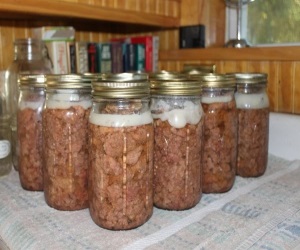
While I have raw packed poultry, I have found that it is much nicer and more efficient to hot pack it. Here you precook the meat and pack it hot into hot jars. When I raw packed my chickens that we were butchering in a hurry, the canning went fast. But when it was finished, there was a whole lot of jar and not so much meat left down in the bottom of it, and the end product did not look appetizing as it does with hot packed poultry. Another drawback is that the raw packed poultry tended to be a little chewy after processing and storage, as it kind of dried out. So today I do nearly all my poultry using the hot pack method.
You may use these directions for any poultry, fowl, or game birds.
Boil or bake the birds until nearly done, so the meat will pull easily off the bones. I prefer to remove the bones and boil them up for broth to cover the meat. In this way, no space in the jar is taken up by bones.
I pack my poultry into both pint and half-pint jars. The widemouth pints contain whole or large pieces of breast. If you have a large family, you may want to use widemouth quarts for the same choice pieces of meat. Regular jars can hold the large pieces of meat from the legs and thighs. Or you can dice all the leftover meat into them. This is handy to use for a huge assortment of recipes. In the store, less than a half-pint of diced chicken breast is over $2.00.
I usually remove the breasts and can those in large pieces or whole, depending on the size of the birds. The rest of the bird I dice up, as I use a whole lot of diced poultry meat in mixed recipes from chicken enchiladas to chicken noodle soup.
Like I said, I boil or steam the bird, debone it, and pack it into hot jars. Then I ladle the grease off the broth and pour the broth over the meat, to within an inch of the top of the jars. Remove air bubbles. This boned meat is processed at 10 pounds pressure (see altitude chart) for 75 minutes for pints and 90 minutes for quarts. Bone-in poultry meat is processed for less time due to the spacing the bones create, allowing the meat to heat quicker and more thoroughly. This is processed at 10 pounds pressure (see altitude chart) for 65 minutes for pints and 75 minutes for quarts.
One reason I like to bone my poultry is that it leaves me with this big pile of bones and a lot of extra broth for making a soup base. I put the bones back in the broth. With a baked turkey, I add water to the roasting pan, mix in the brownings and pour the works in a large stock pot with the turkey carcass or bones. I simmer all the bones for about half an hour, then let it cool down so I can handle the bones. I carefully remove any clinging meat on the bones and put it into a bowl. I put the bones into another bowl and “yucky” scraps into another for the huskies’ treats. Never feed cooked small bones, such as poultry or pork bones to dogs. It can kill them by puncturing their intestines. I skim most of the fat off the cooled broth and add that to the huskies’ dry food. Then I take the little bit of shredded meat I have and put it into several pint or quart jars. I heat up the broth again to boiling, adding some powdered chicken soup base or seasonings, as I like. While that’s heating, I often add a small handful of grated carrots, perhaps a few peas, parsley or whatever I want, a handful of rice or dry noodles, then add the broth to within an inch of the top of the jar. Process at 10 pounds pressure (see altitude chart) for 75 minutes (pints) or 90 minutes (quarts). I usually use regular mouth quart jars, since I usually use a quart of this ready-made soup base at a time.
A few last hints
Use a broth on your meat, not a heavy gravy. Thick, flour thickened gravies canned with your meat could prevent the meat from quickly heating thoroughly while processing.
Always wipe the rim of your jars after filling, with a warm, damp, clean cloth. Grease on a jar rim is your enemy; it can prevent the jars from sealing.
If a jar does not seal, reprocess it with a new, previously simmered lid right away, or refrigerate until you can. (Reheat it before you again put it into your canner.) If it’s a single jar and you’re through canning, simply use it soon in a home-cooked meal.
Always check a jar before you re-heat it to use. Make sure the seal is still firmly indented in the center and that you have to really pry to remove the lid. If it comes off easily it’s not sealed. Now look at the contents. Do they look appetizing and normal? Does the meat smell great? Before tasting the meat, heat it to boiling temperature for 10-15 minutes (longer for altitudes above 1,000 feet) before tasting or serving. You do not have to boil the meat, but make sure you heat it to boiling temperature which ever way you prepare it, be it in a casserole, a stew, roasted in the oven, etc. By doing this every time you use a jar of your home canned meat, you will ensure that you and your family are safe from food poisoning.
Always read your canning manual before attempting to can anything. It’s only common sense.
I hope you are off on the road to a whole new way of food storage. While many people home can pickles, jams, and jellies, not so many attempt meats. And because they’re so good and easy to can, they’re missing a whole lot. So, try putting up some meat. You’ll soon discover how truly indispensable they are! Good canning!
Here’s just a glimpse of what you’ll find inside Old Time Wisdom
You’ll discover the ancient meat preservation method that will make your mouth water. Enjoying the delicious sweet-smoky taste of beef, pork, or link sausages for months to come… without ANY refrigeration, chemicals, preservatives, or additives!
And you can prepare everything in your back-yard (or balcony) in one afternoon– I promise it will be more relaxing than taking the day off to go fishing.
You’ll also learn how to get rid of the toxic canned food from the supermarket… and preserve your own healthy & delicious vegetables and fruits. All you need is Granddad Bob’s secret canning trick to instantly kill bacteria and parasites…
… and eliminate ANY toxic preservatives so you can keep your food in perfect condition for a full year, with all nutrients and vitamins intact.
Books can be your best pre-collapse investment.
Carnivore’s Bible (is a wellknown meat processor providing custom meat processing services locally andacross the state of Montana and more. Whether your needs are for domestic meator wild game meat processing)
The Lost Book of Remedies PDF ( contains a series of medicinal andherbal recipes to make home made remedies from medicinal plants and herbs.Chromic diseases and maladies can be overcome by taking the remediesoutlined in this book. The writer claims that his grandfather was taughtherbalism and healing whilst in active service during world war twoand that he has treated many soldiers with his home made cures. )
Easy Cellar(Info about building and managing your root cellar, plus printable plans. The book on building and using root cellars – The Complete Root Cellar Book.)
The Lost Ways (Learn the long forgotten secrets that helped our forefathers survive famines,wars,economic crisis and anything else life threw at them)
LOST WAYS 2 ( Wordof the day: Prepare! And do it the old fashion way, like our fore-fathers did it and succeed longbefore us,because what lies ahead of us will require all the help we can get. Watch this video and learn the 3 skills that ensured our ancestors survival in hard times offamine and war.)

